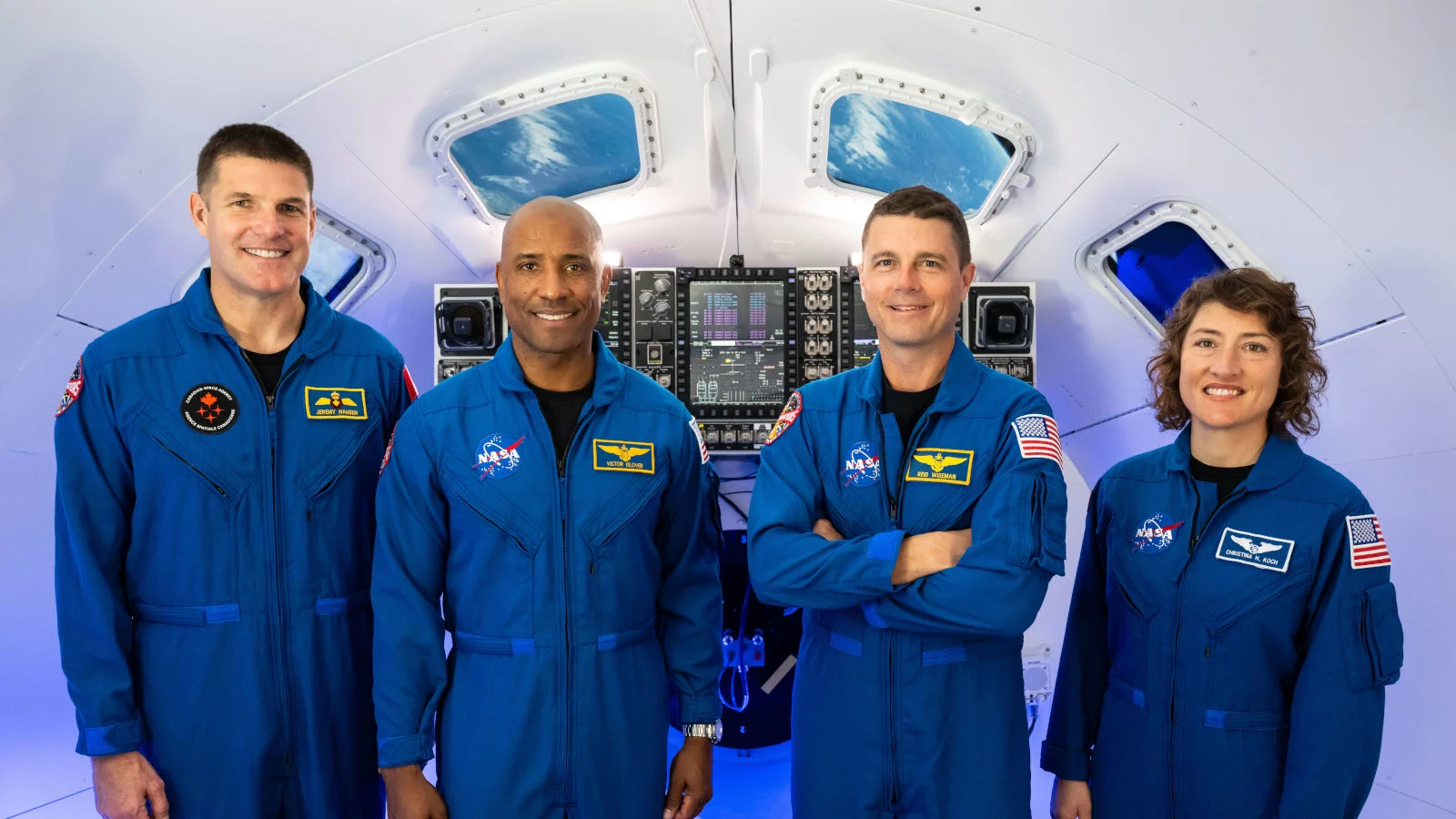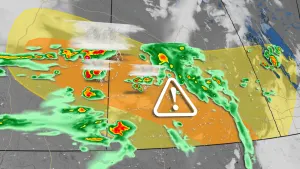
Canadian astronaut Jeremy Hansen chosen to fly around the Moon on Artemis 2
Canada will become the second nation to reach deep space and the Moon.
Astronaut Jeremy Hansen has been chosen as the first Canadian to ever visit deep space and the Moon.
By late 2024, NASA plans to launch Artemis II, a mission to carry four astronauts on a trip around the Moon and back. On Monday, April 3, 2023, NASA and the Canadian Space Agency announced the members of this historic crew — Reid Wiseman, Victor Glover, Christina Koch, and Canadian astronaut Jeremy Hansen.
Artemis II will be the first crewed mission to fly to the Moon in over 50 years. It will also be the first time a person of colour has flown to deep space and the Moon, as well as the first time a woman has achieved those goals. Finally, with Jeremy Hansen joining the crew, it will be the first time a Canadian has flown beyond low-Earth orbit.

The Artemis II crew in an Orion simulator at NASA's Johnson Space Center in Houston. From left to right: Jeremy Hansen (mission specialist), Victor Glover (pilot), Reid Wiseman (mission commander), Christina Koch (mission specialist). Credit: NASA/James Blair
"The Artemis II crew represents thousands of people working tirelessly to bring us to the stars. This is their crew, this is our crew, this is humanity's crew," NASA Administrator Bill Nelson said Monday morning during the announcement ceremony at Johnson Space Center in Houston. "NASA astronauts Reid Wiseman, Victor Glover, and Christina Hammock Koch, and CSA astronaut Jeremy Hansen, each has their own story, but, together, they represent our creed: E pluribus unum – out of many, one. Together, we are ushering in a new era of exploration for a new generation of star sailors and dreamers – the Artemis Generation."
"We are going back to the Moon and Canada is at the centre of this exciting journey," said François-Philippe Champagne, Canada's Minister of Innovation, Science and Industry. "Thanks to our longstanding collaboration with NASA, a Canadian astronaut will fly on this historic mission."
"On behalf of all Canadians, I want to congratulate Jeremy for being at the forefront of one of the most ambitious human endeavours ever undertaken," Minister Champagne added. "Canada's participation in the Artemis program is not only a defining chapter of our history in space, but also a testament to the friendship and close partnership between our two nations."
Who is Jeremy Hansen?
Jeremy Hansen was selected to represent Canada in space, along with David Saint-Jacques, in 2009.
Growing up in southwestern Ontario, Hansen has been a fan of Star Wars since he was a kid, and has said that he's never known a time when he hasn't wanted to be an astronaut. He's been flying since he was a teenager, as part of the Air Cadets, he served as a CF-18 fighter pilot in the Canadian Armed Forces, and has degrees in space sciences and physics.
When asked why he wanted to become an astronaut, Hansen replied: "The idea of exploring new places and accomplishing the seemingly impossible excites me."

"We are going to the Moon together. Let's go!' says CSA astronaut Jeremy Hansen during the announcement on April 3, 2023. Credit: NASA TV
During his time as an astronaut, Hansen has served as Capcom, the communication liaison between the Mission Control Center at Johnson Space Center in Houston, Texas and the astronauts in space and on the International Space Station. He is also the first Canadian to lead a NASA astronaut class, training the next batch of American and Canadian astronauts for the missions they will fly in the future.
And in 2024, on his very first mission, Hansen will become the first Canadian in deep space and the first to visit the Moon.
"Being part of the Artemis II crew is both exciting and humbling," Hansen said on Monday. "I'm excited to leverage my experience, training, and knowledge to take on this challenging mission on behalf of Canada. I'm humbled by the incredible contributions and hard work of so many Canadians that have made this opportunity a reality. I am proud and honoured to represent my country on this historic mission."
Watch below: CSA astronaut Jeremy Hansen’s journey to the Moon
What is Artemis II?
Artemis is NASA's initiative to return humans to the Moon, with the ultimate goal of establishing a permanent presence in lunar orbit, and supporting the first human missions to the planet Mars.
The Artemis I mission launched in November 2022, as a test mission for the Space Launch System booster rocket and the Orion spacecraft. On board the uncrewed spacecraft were sensors and instruments designed to test what future astronauts would endure on this same mission.

Orion splashes down off the coast of Baja California on December 11, 2022. Credit: NASA
After travelling over 2.2 million kilometres, making two flybys of the Moon and then returning to Earth for splashdown, the mission was considered a great success for NASA.
Artemis II is the follow-up to this. With the uncrewed test mission going so well, the next step is to fly the same mission with four astronauts on board.
According to NASA:
Artemis II is the first crewed mission aboard NASA's foundational human deep space capabilities: the Space Launch System rocket, Orion spacecraft, and the ground systems needed to launch them. The approximately 10-day mission will test and stress the Orion spacecraft's life-support systems to prove the capabilities and techniques required to live and work in deep space in ways only humans can do.

This diagram shows the path Orion will take as it flies on the Artemis II mission, carrying four astronauts on the next phase of human space exploration. Credit: NASA
"This mission ... would make Canada the second country to have an astronaut fly around the Moon," the Canadian Space Agency says on their website. "During Artemis II, the crew will set a record for the farthest human travel beyond the far side of the Moon."
The current records for the farthest distance beyond the far side of the Moon and the farthest distance travelled from Earth are held by NASA astronauts Jim Lovell, John Swigert, and Fred Haise during Apollo 13 in April of 1970. The mission may be famous for the accident that endangered the crew and caused them to miss their opportunity to visit the lunar surface. However, when they entered lunar orbit on April 14, they were 254 kilometres beyond the Moon's far side and a total of 400,171 kilometres from Earth — both record distances for a crewed spacecraft.
For the Artemis II mission, there is no way of knowing the total distance the Orion spacecraft will travel from Earth until the day it lifts off from Kennedy Space Center. However, it is expected to fly by the far side of the Moon at a distance of over 7,400 kilometres. So, that — in of itself — will set a new space record. If the mission's timing puts the Moon far enough away, the Artemis II crew could also break Apollo 13's record distance from Earth.
Following Artemis II, NASA plans to launch Artemis III sometime in 2025, which will deliver humans to the surface of the Moon for the first time since December 1972. The success of these missions will act as stepping stones to establishing the Lunar Gateway Station — the first space station in lunar orbit — and in the long run, to support the first human exploration of the planet Mars.
(Thumbnail image courtesy NASA)










